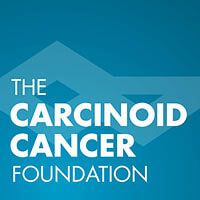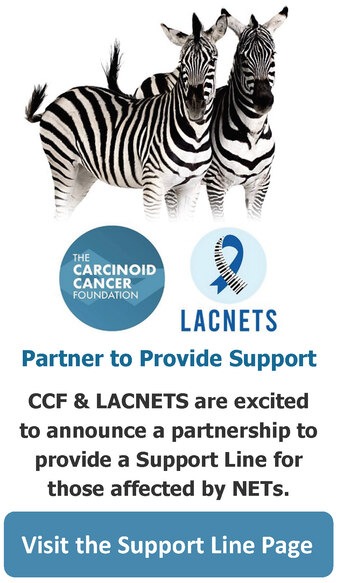The Carcinoid Cancer Foundation and ACOR (Association of Cancer Online Resources) are pleased to announce that selected archival questions posted on the ACOR Carcinoid e-group will now be available on CCF’s website. We hope to expand the archives throughout the year. The ACOR Carcinoid e-group has existed since 1997. Its current seven co-list managers have arranged to share the advice and wisdom of its members (now more than 1,000) on topics that are frequently discussed or are of urgency. ACOR, founded by Gilles Frydman, is a large collection of cancer-related Internet mailing lists, delivering over 1.5 million e-mail messages weekly to subscribers across the globe.
Anyone interested in joining the Carcinoid e-group may either:
- Write to carcinoid-subscribe@listserv.acor.org and follow the directions to confirm the subscription
- Go to http://listserv.acor.org/SCRIPTS/WA-ACOR.EXE?SUBED1=carcinoid&A=1.
Disclaimer: All information provided on this website is strictly for educational purposes and does not constitute professional medical advice, diagnosis, treatment, or care. Please see the complete Disclaimer by CLICKING HERE.
Carcinoid Crisis and Surgery, Preventing During or After
The NOLA (New Orleans, Louisiana) NETS group uses this–others use less–can’t speak to their results but even with these “higher than others” type dosing we have had 2 carcinoid crisis out of about 400 OR (operating room) visits.
- Two hours before surgery give 500 micrograms of octreotide acetate IV (intravenous) Push
- Then start a 500 microgram per hour IV infusion — start this immediately after the IV push and continue infusion during and after surgery
- Depending on the severity and duration of surgery — taper the infusion over 1-24 hours–say for colonoscopy taper over 1 hour — after huge liver cases taper over 12-24 hours
- If patient crashes don’t use pressors (except as a last resort if the following fails) — use fluids and 1-5 mg bolus of octreotide (can repeat) — for malignant hyperthermia use dantrolene in normal doses
Hope this helps. If all else fails print this out and hand it to your anesthesia person along with my cell phone number 504-884-3555 – if they get into trouble have ’em call me day or night.
Eugene A. Woltering MD FACS
The James D. Rives Professor of Surgery and Neurosciences LSUHSC Department of Surgery New Orleans LA 70112
Black Raspberry Powder Dosage
Special thanks to Eugene A. Woltering, MD for providing this information.
One gram per kg body weight in quart of warm water (here’s a pounds to kilograms converter tool, www.rapidtables.com)
Mix, let set for a couple of hours then put in refrigerator overnight
Filter and drink liquid over next 24 hours
Pitch seeds
Communicating with Your Doctors, Suggestions for
Communication – the way to good treatment (no link)
(thanks to Lucy W.)
Sunday, February 13, 2011
Before I go to the doctor, I write up my current meds, symptoms
And any problems I’m having. I number them and leave white space
between the problems.
At the top of each page, I put my name and birth date and “Enter this into my records.” I make two copies.
I try to be brief as possible. When I get to the doctor’s office, I ask that one copy of my document be placed in my file before I see the doctor. That way, there’s at least a chance he or she will glance at it.
When I see the doctor, I get out my copy of the document and make notes under each section. When I am seeing more than one doctor about the same problem, I make sure other members of the treatment team get copies of my document with my notes on it. For example: “Problem with insomnia. Rx Ambien CR – Dr. So-and-so.”
That cuts down on tedious repetition and makes for fewer mistakes. I believe 90 percent of the problems we have with medical professionals can be traced to poor communication.
There’s strength in numbers. When one of our favorite local oncologists moved away, two of us drafted a carcinoid patients’ manifesto and interviewed two oncs who were interested in treating patients with our disease. It was easier for us to do this together than trying to arrange a no-charge interview alone. This is a role for local support groups and I hope more groups will try this, if needed.
Life is too short (I think we all know how short) to deal with doctors who either don’t care or don’t know and still don’t care, about you as a patient. When you find one, make the communication as easy and complete as possible.
Ask if your doctor will communicate via email. Do NOT send them everything that comes your way – just the pertinent info and any questions you might have after the visit. When in doubt, pick up the phone and call them. You probably will not get to speak directly with the doc but a message is likely to get through to them.
Never assume that if your test results were abnormal, “someone” will call you. Follow up on your own. Ask for copies of every test and scan. You never know when they will be important.
Five E’s to Avoid
(thanks to Jan. J., originally from Dr. Eugene Woltering)
November 30, 2009
Like everything else with carcinoid, the five E’s also boil down to what the individual can or cannot tolerate.
Exercise – please do, but do not “overexercise” which could bring on excessive flushing and other symptoms. Guess this means you need to pace yourself. I like to swim and exercise in the water and do not seem to have a problem with that while Dann the Bear can walk miles and miles with ease.
Emotion – Try to keep an even keel – as if. Anger is especially apt to tip one over the edge into symptoms. For me, stress can have me running for the bathroom as fast as possible.
Ethanol – that’s alcohol. Some of us can still imbibe (though very little); some of us can’t. Red wine seems to be a particular culprit in bringing on symptoms.
Eating – this is tricky. Check the nutrition section on the Carcinoid Foundation website for foods to avoid. Mostly this is spicy food (unless you are really, really used to it) and “aged foods” like salami, certain cheeses, etc. Here again – for me- it is cooked tomatoes (think spaghetti with red sauce and pizza) and any kind of citrus.
Epinephrine – It’s the first thing EMTs want to inject if one is having an allergic reaction or a heart problem (guess if there is no other choice one gets epi – but they need to be aware of the effect it could have). At the dentist’s, ask for the novacaine without epinephrine. I find that codeine has the same effect on me as epinephrine. In fact, one of the things to be wary about are certain things that end in “ine” – but on the other hand, morphine ends in “ine” and most of us get that after surgery.
Some of these things to avoid may be a matter of “trial and error” – but hopefully, the errors will not be disastrous.
Mostly this is common sense with what our bodies can put up with.
We are each so different from the other.
Carcinoid: Not a one-size-fits-all kind of disease.
PRRT and Radioembolization, Combination of — May Be a Bad, Newly Recognized Problem
In a July 29, 2013 ACOR post, Dr. Eugene Woltering shared the following information: We have several deaths now in folks who had PRRT and radioembolization — there was evidence of liver damage after the PRRT — WE THINK IT IS DUE TO RADIATION-INDUCED HEPATITIS.
If so, this is a newly recognized problem that you may wish to consider when faced early on with the need for liver-directed therapy — chemoembolization or bland embolization rather than radioactive spheres may be the way to go –we have been big advocates of the radioactive spheres in the past due to the easy therapy and the lack of side effects.
No one counted on the combo of radioembolization and PRRT being a problem in the future.
7 Ways to Help Your Doctor Become More Familiar with Carcinoid and Neuroendocrine Tumors (from Linda Silversmith)
1. Book: Ask InterScience Institute to send the doc a free copy of the book on diagnosing and monitoring carcinoid (info is on ISI website –http://www.interscienceinstitute.com/)
2. Organization: Request that the doc join the North American NeuroEndocrine Tumor Society (www.nanets.net)
3. Confer: Request that the doc confer by phone or email with one or more specialists (and provide contact info)
4. E-group: Request that the doc join the e-group where local docs can ask carcinoid specialists questions (provide this link:https://www.carcinoid.org/for-doctors/other-resources/online-discussion)
5. Print papers: Regularly print out and give the doc(s) copies of important research papers from among those listed at www.carcinoid.org (use liberal highlighting)
6. Know and share information: If you are on LAR or daily octreotide, print out and underline important parts of the prescribing info – with a copy for you and a copy for your doc. Get printed copies from pharmacist or see http://www.sandostatin.com/about-sandostatin-lar/sandostatin-lar-safety-information.jsp.
7. Chart: Keep a chart for yourself as to which of the above things you have done and which you still need to do (including regular checking for new references to share)
Yellow Corvette Parable
A man walks into the local Chevy dealer with $60,000 cash in his pocket.
He is strolling around the lot when a nice old guy walks up to him and asks him what he would like to buy.
The potential buyer says that all of his life he wanted a new yellow Corvette. HE TELLS THE DEALER THAT HE HAS $60,000 IN HIS POCKET AND IS READY TO BUY THE NEW CORVETTE TODAY!
The old guy says that he will sell him a red, blue, green, silver, black, or gold corvette but that he will not sell him a yellow corvette… BECAUSE HE DOESN’T HAVE ONE IN STOCK AND WON’T ORDER ANYONE A NEW YELLOW CORVETTE …EVEN IF THEY HAVE $60,000 IN THEIR POCKET!
What should he do? The answer is obvious in this case. He should go to another dealer!
What is not obvious is the MORAL of this story…
If you are being treated by a doctor who is not knowledgeable about this disease (and doesn’t want to get educated on the disease) or will not work with you and a carcinoid expert to get you the best care available… YOU NEED A NEW DOCTOR!
Medicine is a life saving art but oh too many docs look at it as a way to make a living and don’t look at the patient’s needs. They offer “JUST WHAT THEY HAVE ON THE LOT”!
If you have a doc who will work with you and your other doctors, refer all of your local “noids” to him! Pronto!! He is a KEEPER!
BUT IF YOUR DOC GIVES YOU THE “ATTITUDE”, YOU NEED A NEW DOC!
PERIOD…END OF DISCUSSION!
YOU ARE FAR MORE VALUABLE THAN ANY CAR!
The parable of THE YELLOW CORVETTE was shared by:
Eugene Woltering, MD, FACS
The James D. Rives Professor of Surgery and Neurosciences Chief of Sections of Surgical Oncology and EndocrinologyDirector of Surgical Research, LSUHSC Neuroendocrine – Carcinoid Tumors Ochsner Neuroendocrine Tumor Clinic 200 West Esplanade, Suite 200, Kenner, LA 70065 Phone: (504) 464-8500 1-866-91-ZEBRA Fax: (504) 464-8525


